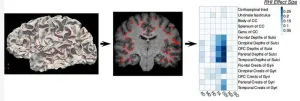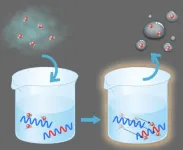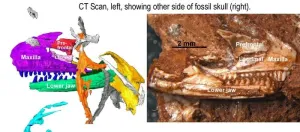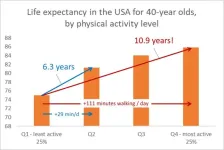(Press-News.org) CHICAGO – Soccer heading may cause more damage to the brain than previously thought, according to a study being presented next week at the annual meeting of the Radiological Society of North America (RSNA).
Heading is a widely used technique in soccer where the players control the direction of the ball by hitting it with their head. In recent years, research has been done that suggests a link between repeated head impacts and neurodegenerative diseases, such as chronic traumatic encephalopathy (CTE).
“The potential effects of repeated head impacts in sport are much more extensive than previously known and affect locations similar to where we’ve seen CTE pathology,” said study senior author Michael L. Lipton, M.D., Ph.D., professor of radiology at Columbia University Irving Medical Center in New York. “This raises concern for delayed adverse effects of head impacts.”
While prior studies have identified injuries to the brain’s white matter in soccer players, Dr. Lipton and colleagues utilized a new approach to an advanced brain imaging technique called diffusion MRI to analyze microstructure close to the surface of the brain.
To identify how repeated head impacts affect the brain, the researchers compared brain MRIs of 352 male and female amateur soccer players, ranging in age from 18 to 53, to brain MRIs of 77 non-collision sport athletes, such as runners.
Soccer players who headed the ball at high levels showed abnormality of the brain’s white matter adjacent to sulci, which are deep grooves in the brain’s surface. Abnormalities in this region of the brain are known to occur in very severe traumatic brain injuries.
The abnormalities were most prominent in the frontal lobe of the brain, an area most susceptible to damage from trauma and frequently impacted during soccer heading. More repetitive head impacts were also associated with poorer verbal learning.
“Our analysis showed that the white matter abnormalities represent a mechanism by which heading leads to worse cognitive performance,” Dr. Lipton said.
Most of the participants of the study had never sustained a concussion or been diagnosed with a traumatic brain injury. This suggests that repeated head impacts that don’t result in serious injury may still adversely affect the brain.
“The study identifies structural brain abnormalities from repeated head impacts among healthy athletes,” Dr. Lipton said. “The abnormalities occur in the locations most characteristic of CTE, are associated with worse ability to learn a cognitive task and could affect function in the future.”
The results of this study are also relevant to head injuries from other contact sports. The researchers stress the importance of knowing the risks of repeated head impacts and their potential to harm brain health over time.
“Characterizing the potential risks of repetitive head impacts can facilitate safer sport engagement to maximize benefits while minimizing potential harms,” Dr. Lipton said. “The next phase of the study is ongoing and examines the brain mechanisms underlying the MRI effects and potential protective factors.”
Co-authors are Bluyé Demessie, A.B., M.S., Walter F. Stewart, Ph.D., Richard B. Lipton, M.D., Molly E. Zimmerman, Ph.D., Mimi Kim, Sc.D., Kenny Ye, Ph.D., Thomas Kaminski and Roman Fleysher, Ph.D.
This study was funded by the National Institutes of Health and The Dana Foundation.
###
Note: Copies of RSNA 2024 news releases and electronic images will be available online at RSNA.org/press24.
RSNA is an association of radiologists, radiation oncologists, medical physicists and related scientists promoting excellence in patient care and health care delivery through education, research and technologic innovation. The Society is based in Oak Brook, Illinois. (RSNA.org)
For patient-friendly information on brain MRI, visit RadiologyInfo.org.
END
A new study has linked distinct neural and behavioral characteristics in autism spectrum disorder to a simple computational principle. Centered on the “dynamic range” of neurons, which reflects how gradually or sharply they respond to input, the study suggests that individuals with autism spectrum disorder have an increased dynamic range in their neuronal response, resulting in a more detailed but slower response to changes. This research defies previous descriptions of ASD as a “broken cog in the machine” and provides a deeper, richer account of the computational basis of ASD.
[Hebrew University of Jerusalem]– Researchers Dr. Yuval Hart and Oded ...
Large language models, a type of AI that analyses text, can predict the results of proposed neuroscience studies more accurately than human experts, finds a new study led by UCL (University College London) researchers.
The findings, published in Nature Human Behaviour, demonstrate that large language models (LLMs) trained on vast datasets of text can distil patterns from scientific literature, enabling them to forecast scientific outcomes with superhuman accuracy.
The researchers say this highlights ...
As we age, our cognitive and motor functions deteriorate, which in turn affects our independence and overall quality of life. Research efforts to ameliorate or even completely abolish this have given rise to technologies that show a lot of promise.
Among these is non-invasive brain stimulation: a term encompassing a set of techniques that can affect brain functions externally and noninvasively, without the need for surgery or implants. One such promising technique, in particular, is anodal transcranial direct current stimulation (atDCS), which uses ...
Harvesting water from the air and decreasing humidity are crucial to realizing a more comfortable life for humanity. Water-adsorption polymers have been playing a key part in atmospheric water harvesting and desiccant air conditioning, but desorption so that the polymers can be efficiently reused has been an issue. Now, Osaka Metropolitan University researchers have found a way to make desorption of these polymers more efficient.
Usually, heat of around 100°C is required to desorb these polymers, but Graduate School of Engineering student Daisuke Ikegawa, Assistant Professor Arisa Fukatsu, ...
A large new population study of men over 45 indicates insulin resistance may be an important risk factor for the development of the world’s most common heart valve disease – aortic stenosis (AS).
Published today in the peer-reviewed journal Annals of Medicine, the findings are believed to be the first to highlight this previously unrecognised risk factor for the disease.
It is hoped that by demonstrating this link between AS and insulin resistance – when cells fail to respond effectively to insulin and the body makes more than necessary to maintain normal glucose ...
Effective immunity hinges on the ability to sense infection and cellular transformation. In humans, there is a specialised molecule on the surface of cells termed MR1. MR1 allows sensing of certain small molecule metabolites derived from cellular and microbial sources; however, the breadth of metabolite sensing is unclear.
Published in PNAS, researchers at the Monash University Biomedicine Discovery Institute have identified a form of Vitamin B6 bound to MR1 as a means of engaging tumour-reactive immune cells. The work involved an international collaborative team co-led by researchers from the University of Melbourne.
According ...
A collaborative effort by the research groups of Professor Haruhiko Fuwa from Chuo University and Professor Masashi Tsuda from Kochi University has culminated in the structure elucidation and total synthesis of anticancer marine natural products, iriomoteolide-1a and -1b. These natural products were originally isolated from the marine dinoflagellate collected off the Iriomote Island, Okinawa, Japan.
Because of its potent anticancer activity, iriomoteolide-1a is an intriguing natural product that attract immense attention from the chemical community around the globe. ...
A storeroom specimen that changed the origins of modern lizards by millions of years has had its identity confirmed.
The tiny skeleton, unearthed from Triassic-aged rocks in a quarry near Bristol, is at least 205 million years old and the oldest modern-type lizard on record.
Recently, the University of Bristol team’s findings came under question, but fresh analysis, published today in Royal Society Open Science, proves that the fossil is related to modern anguimorphs such as anguids and monitors. The discovery ...
If everyone in the United States population was as active as the top 25 per cent, individuals over the age of 40 could add five years to their life, according to a new study led by Griffith University researchers.
Physical activity has long been known to be good for health, however estimates have varied regarding how much benefit could be gained from a defined amount of activity, both for individuals and for populations.
This latest study used accelerometry to gain an accurate view of the population’s physical activity levels instead of relying on survey responses as per other studies, and found the benefits were around twice as strong ...
Plants need light to grow, but too much light can induce damage to the photosynthetic complex known as photosystem II. It is known that plants adapted to growing under full sun repair this light-induced damage more. But this repair activity slows down in colder temperatures. An Osaka Metropolitan University-led international research team has now found some clues to how plants survive in colder regions.
Graduate School of Science Associate Professor Riichi Oguchi and colleagues from Australia, Austria, and Japan grew Arabidopsis thaliana (commonly ...





